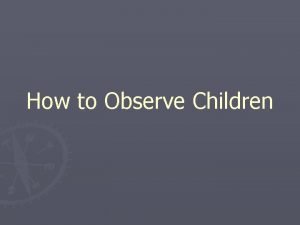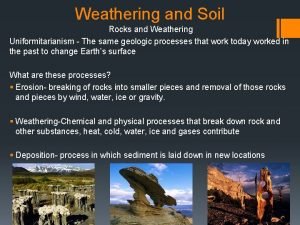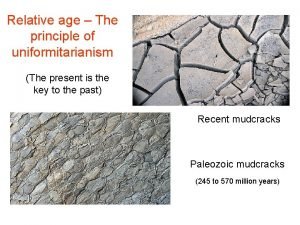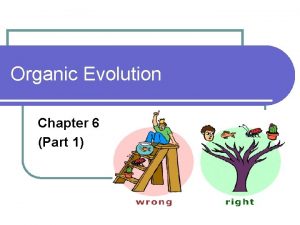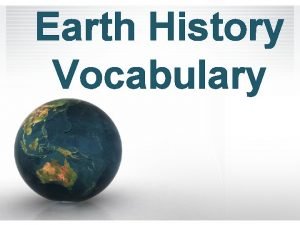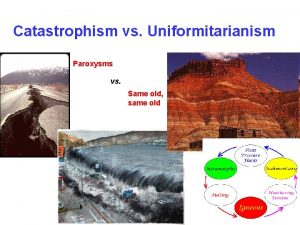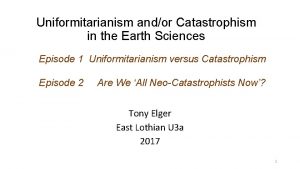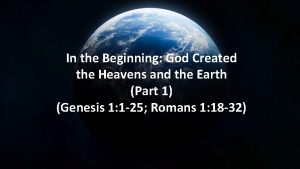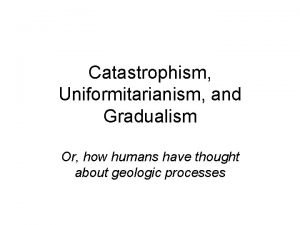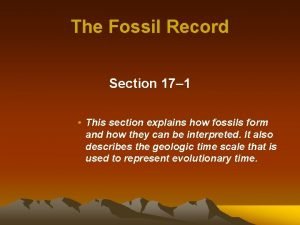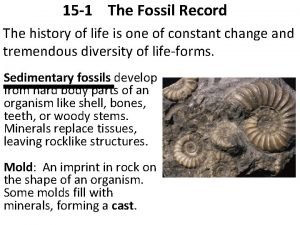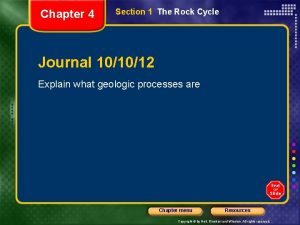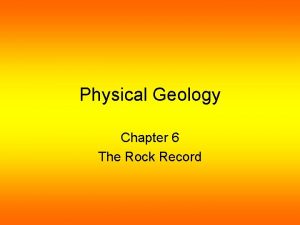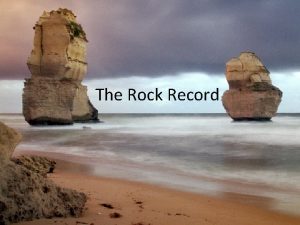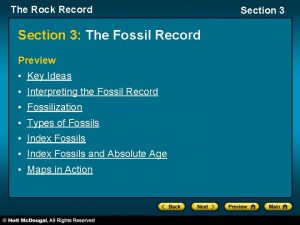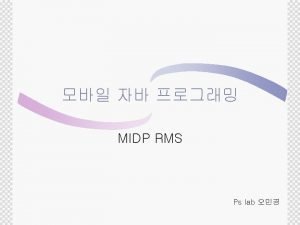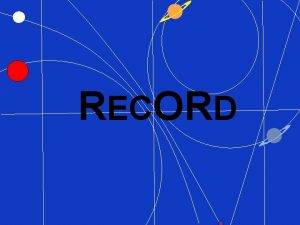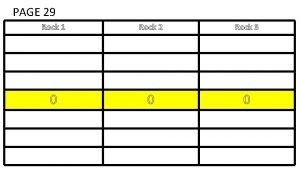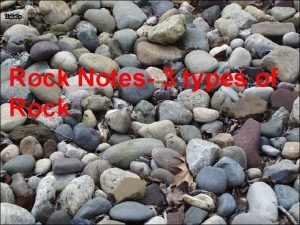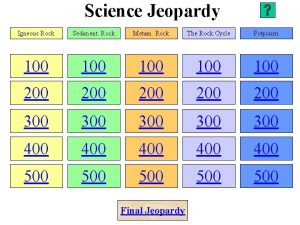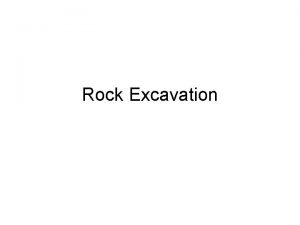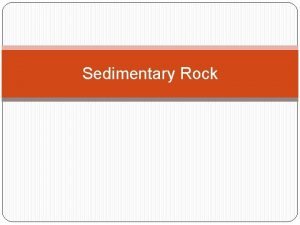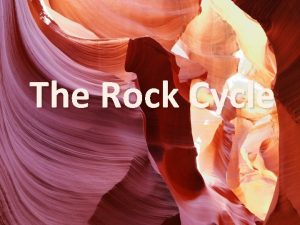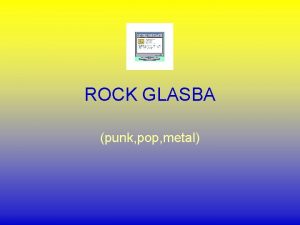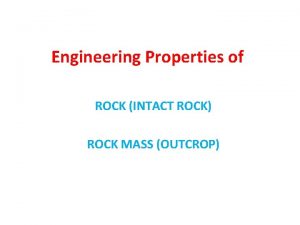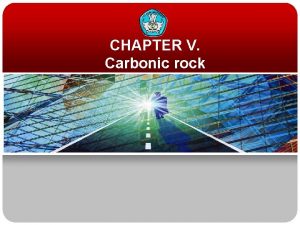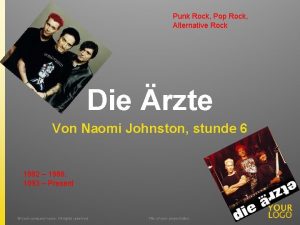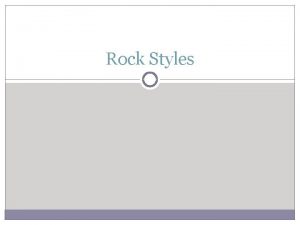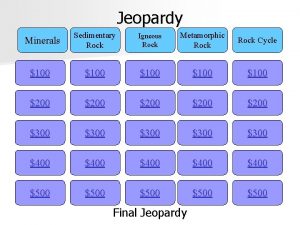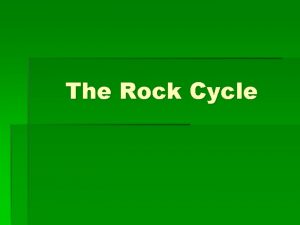The Rock Record Section 1 Uniformitarianism uniformitarianism a


















































- Slides: 50

The Rock Record Section 1 Uniformitarianism • uniformitarianism a principle that geologic processes that occurred in the past can be explained by current geologic processes • Geologists estimate that Earth is about 4. 6 billion years old, an idea that was first proposed by James Hutton in the 18 th century. • Hutton theorized that the same forces that change Earth’s surface now, such as volcanism and erosion, are the same forces that were at work in the past.

The Rock Record Section 1 Uniformitarianism, continued Earth’s Age • Before Hutton’s research, most scientists thought Earth was only 6, 000 years old, and that all Earth’s geologic features had formed at the same time. • Hutton’s observed that the forces that changed the land on his farm operated very slowly and reasoned that millions of years must be needed for those same forces to create the complicated rock structures in Earth’s crust. • Hutton’s ideas about uniformitarianism encouraged other scientists to learn more about Earth’s history.

The Rock Record Section 1 Relative Age • relative age the age of an object in relation to the ages of other objects • One way to learn about Earth’s past is to determine the order in which rock layers and other rock structures formed. • Layers of rock, called strata, show the sequence of events that took place in the past.

The Rock Record Section 1 Relative Age, continued • Using a few basic principles, scientists can determine the order in which rock layers formed. • Once they know the order, a relative age can be determined for each layer. • Relative age indicated that one layer is older or younger than another layer but does not indicate the rock’s age in years.

The Rock Record Section 1 Law of Superposition • law of superposition the principle that a sedimentary rock layer is older than the layers above it and younger than the layers below it if the layers are not disturbed • Scientists commonly study the layers in sedimentary rocks to determine the relative age of rocks. • Sedimentary rocks form when new sediments are deposited on top of old layers of sediment. • As the sediments accumulate, they harden into layers called beds. The boundary between two beds is called a bedding plane.

The Rock Record Section 1 Law of Superposition, continued • Scientists use a basic principle called the law of superposition to determine the relative age of a layer of sedimentary rock. • The law of superposition states that an undeformed rock layer is older than the layers above it and younger than the layers below it.

The Rock Record Section 1 Law of Superposition, continued The diagram below illustrates the law of superposition.

The Rock Record Section 1 Principle of Original Horizontality • Scientist know that sedimentary rock generally forms in horizontal layers. • The principle of original horizontality states that sedimentary rocks left undisturbed will remain in horizontal layers. • Scientists can assume that sedimentary rock layers that are not horizontal have been tilted or deformed by crustal movements that happened after the layers formed. • In some cases, tectonic forces push older layers on top of younger ones or overturn a group of rock layers. So, scientists must look for clues to the original position of the layers.

The Rock Record Section 1 Principle of Original Horizontality, continued Graded Bedding • One clue is the size of particles in the layers. In some environments, the largest particles of sediment are deposited in the bottom layers. • The arrangement of layers in which coarse and heavy particles are in the bottom layers is called graded bedding. • If larger particles are located in the top layers, the layers may have been overturned by tectonic forces.

The Rock Record Section 1 Principle of Original Horizontality, continued Cross-Beds • Another clue to the original position fo rock layers is in the shape of the bedding planes. • When sand is deposited, sandy sediment forms beds at an angle to the bedding plane. • These beds are called cross-beds. Scientists can study the shape of the cross-beds to determine the original position of the layers.

The Rock Record Section 1 Principle of Original Horizontality, continued Ripple Marks • Ripple marks are small waves that form on the surface of sand because of the action of water or wind. When the sand becomes sandstone, the ripple marks may be preserved. • In undisturbed sedimentary rock layers, the crests of the ripple marks point upward. • Scientists study the orientation of the ripple marks to determine the original arrangement of the rock layers.

The Rock Record Section 1 Unconformities • Movements of Earth’s crust can lift up rock layers that were buried and expose them to erosion. • Then, if sediments are deposited, new rock layers form in place of the eroded layers. • The missing layers create a break in the geologic record, called an unconformity. • unconformity a break in the geologic record created when rock layers are eroded or when sediment is not deposited for a long period of time.

The Rock Record Section 1 Unconformities, continued • There are three types of unconformities. • A nonconformity is an unconformity in which stratified rock rests upon unstratified rock. • An angular unconformity is the boundary between a set of tilted layers and a set of horizontal layers. • A disconformity is the boundary between horizontal layers of old rock and younger, overlying layers that are deposited on an eroded surface.

The Rock Record Unconformities, continued The diagram below illustrates the three types of unconformities. Section 1

The Rock Record Section 1 Unconformities, continued Crosscutting Relationships • A fault is a break or crack in Earth’s crust along which rocks shift their position. An intrusion is a mass of igneous rock that forms when magma is injected into rock. • When rock layers have been disturbed by faults or intrusions, scientists use the law of crosscutting relationships to determine the order of the layers. • law of crosscutting relationships the principle that a fault or body of rock is younger than any other body of rock that it cuts through.

The Rock Record Section 1 Crosscutting Relationships The law of crosscutting relationships can be used to determine the relative ages of rock layers.

The Rock Record Section 1 Absolute Dating Methods • absolute age the numeric age of an object or event, often stated in years before the present, as established by an absolute-dating process, such as radiometric dating • Scientists use a variety of ways to determine absolute age of a rock formation. • Some methods involve geologic processes that can be observed and measured over time. • Other methods involve the chemical composition of certain materials in rock.

The Rock Record Section 1 Absolute Dating Methods, continued Rates of Erosion • One way scientists use to estimate absolute age is to study rates of erosion. • Studying the rates of erosion is practical only for geologic features that formed within the past 10, 000 to 20, 000 years. • For older surface features, the method is less dependable because rates of erosion can vary over millions of years.

The Rock Record Section 1 Absolute Dating Methods, continued Rates of Deposition • Scientists can also estimate absolute age by calculating the rate of sediment deposition. • By using data collected over a long period of time, geologists can estimate the average rates of deposition for common sedimentary rocks. • This method is not always accurate because not all sediment is deposited at an average; therefore it provides only an estimate of absolute age.

The Rock Record Section 1 Absolute Dating Methods, continued Varve Count • Some sedimentary deposits show definite annual layers, called varves. • varve a pair of sedimentary layers (one coarse, one fine) that is deposited in an annual cycle, commonly in glacial lakes, and that can be used to determine absolute age • The varves can be counted much like tree rings to determine the age of the sedimentary deposit.

The Rock Record Section 1 Radiometric Dating • Rocks generally contain small amounts of radioactive material that can act as natural clocks. • Atoms of the same element that have different numbers of neutrons are called isotopes. • Radioactive isotopes can be used to determine age. • Radioactive isotopes have nuclei that emit particles and energy at a constant rate regardless of surrounding conditions.

The Rock Record Section 1 Radiometric Dating, continued • Scientists use the natural breakdown of isotopes to accurately measure the absolute age of rock, which is called radiometric dating. • radiometric dating a method of determining the absolute age of an object by comparing the relative percentages of a radioactive (parent) isotope and a stable (daughter) isotope. • Scientists measure the concentration of the parent isotope or original isotope, and of the newly formed daughter isotopes. Then, using the known decay rate, they can determine the absolute age of the rock.

The Rock Record Section 1 Radiometric Dating, continued Half-Life • half-life the time required for half of a sample of a radioactive isotope to break down by radioactive decay to form a daughter isotope • Scientists have determined that the time required for half of any amount of a particular radioactive isotope to decay is always the same and can be determined for any isotope. • By comparing the amounts of parent and daughter isotopes in a rock sample, scientists can determine the age of the sample. • The greater the percentage of daughter isotopes present in the sample, the older the rock is.

The Rock Record Radioactive Decay and Half-Life Section 1

The Rock Record Half-Life Click below to watch the Visual Concept. Section 1

The Rock Record Section 1 Radiometric Dating, continued Radioactive Isotopes • Uranium-238, or 238 U, is an isotope of uranium that has an extremely long half-life, and is most useful for dating geologic samples that are more than 10 million years old. • Potassium-40, or 40 K, has a half-life of 1. 25 billion years, and is used to date rocks that are between 50, 000 and 4. 6 billion years old. • Rubidium-87 has a half-life of about 49 billion years, and is used to verify the age of rocks previously dated by using 40 K.

The Rock Record Section 1 Carbon Dating • Younger rock layers may be dated indirectly by dating organic material found within the rock. • Organic remains, such as wood, bones, and shells that are less than 70, 000 years old can be determined by using a method known as carbon-14 dating, or radiocarbon dating. • All living organisms have both the carbon-12 and carbon 14 isotope.

The Rock Record Section 1 Carbon Dating, continued • To find the age of a sample of organic material, scientists first determine the ratio of 14 C to 12 C. • Then they compare that ratio with the ratio of 14 C to 12 C known to exist in a living organism. • While organisms are alive, the ratio of 14 C to 12 C remains relatively constant. Once a plant or animal dies, the ratio begins to change. The amount of 14 C decreases steadily as the amount of 14 C decays to 14 N. • Scientists can determine the age from the difference between the ratios of 14 C to 12 C in the dead organism.

The Rock Record Section 1 Interpreting the Fossil Record • fossils the trace or remains of an organism that lived long ago, most commonly preserved in sedimentary rock. • paleontology the scientific study of fossils. • Fossils are an important source of information for finding the relative and absolute ages of rocks. • Fossils also provide clues to past geologic events, climates, and the evolution of living things over time.

The Rock Record Section 1 Interpreting the Fossil Record, continued • Almost all fossils are discovered in sedimentary rock. • The fossil record provides information about the geologic history of Earth. • Scientists can use this information to learn about how environmental changes have affected living organisms.

The Rock Record Section 1 Fossilization • Only dead organisms that are buried quickly or protected from decay can become fossils. • Generally only the hard parts of organisms, such as wood, bones, shells, and teeth, become fossils. • In rare cases, an entire organism may be preserved. • In some types of fossils, only a replica of the original organism remains. Others merely provide evidence that life once existed. Mummification • Mummified remains are often found in very dry places, because most bacteria which cause decay cannot survive in these places. • Some ancient civilizations mummified their dead by carefully extracting the body’s internal organs and then wrapping the body in carefully prepared strips of cloth.

The Rock Record Section 1 Fossilization, continued Amber • Hardened tree sap is called amber. Insects become trapped in the sticky sap and are preserved when the sap hardens. • In many cases, delicate features such as legs and antennae have been preserved. In rare cases, DNA has been recovered from amber. Tar Seeps • When thick petroleum oozes to Earth’s surface, the petroleum forms a tar seep, which are commonly covered by water. Animals that come to drink the water can become trapped in the sticky tar. • The remains of the trapped animals are covered by the tar and preserved.

The Rock Record Section 1 Fossilization, continued Freezing • The low temperatures of frozen soil and ice can protect and preserve organisms. • Because most bacteria cannot survive freezing temperatures, organisms that are buried in frozen soil or ice do not decay. Petrification • Mineral solutions such as groundwater replace the original organic materials that were covered by layers of sediment with new materials. • Some common petrifying minerals are silica, calcite, and pyrite. • The substitution of minerals for organic material other results in the formation of a nearly perfect mineral replica of the original organism.

The Rock Record Section 1 Types of Fossils • trace fossil a fossilized mark that formed in sedimentary rock by the movement of an animal on or within soft sediment. • In some cases, no part of the original organism survives in fossil form. But the fossilized evidence of past animal movement can still provide information about prehistoric life. • A trace fossils in an important clue to the animal’s appearance and activities.

The Rock Record Section 1 Reading Check What is a trace fossil? A trace fossil is a fossilized evidence of past animal movement, such as tracks, footprints, borings, or burrows, that can provide information about prehistoric life.

The Rock Record Section 1 Types of Fossils, continued Carbon films • Carbonized residues of leaves, stems, flowers, and fish made in soft mud or clay have been found preserved in sedimentary rock. • When original organic material partially decays, it leaves behind a carbon-rich film that displays the surface features of the organism. Molds and Casts • Shells often leave empty cavities called molds within hardened sediment. When a shell is buried, its remains eventually decay and leave an empty space. • When sand or mud fills a mold and hardens, a natural cast forms. A cast is a replica of the original organism.

The Rock Record Section 1 Types of Fossils, continued Coprolites • Fossilized dung or waste materials from ancient animals are called coprolites. • They can be cut into thin sections and observed through a microscope. The materials identified in these sections reveal the feeding habits of ancient animals, such as dinosaurs. Gastroliths • Some dinosaurs had stones in their digestive systems to help grind their food. In many cases, these stones, which are called gastroliths, survives as fossils. • Gastroliths can often be recognized by their smooth, polished surfaces and by their close proximity to dinosaurs remains.

The Rock Record Section 1 Index Fossils • index fossil a fossil that is used to establish the age of rock layers because it is distinct, abundant, and widespread and existed for only a short span of geologic time. • Paleontologists can use index fossils to determine the relative ages of the rock layers in which the fossils are located. • To be an index fossil, a fossil must be present in rocks scattered over a large region, and it must have features that clearly distinguish it from other fossils. • In addition, organisms from which the fossil formed must have lived during a short span of geologic time, and the fossil must occur in fairly large numbers within the rock layers.

The Rock Record Section 1 Index Fossils and Absolute Age • Scientists can use index fossils to estimate absolute ages of specific rock layers. • Because organisms that formed index fossils lived during short spans of geologic time, the rock layer in which an index fossil was discovered can be dated accurately. • Scientists can also use index fossils to date rock layers in separate area. • Index fossils are used to help locate rock layers that are likely to contain oil and natural gas deposits.

The Rock Record Section 1 Multiple Choice 1. A scientist used radiometric dating during an investigation. The scientist used this method because he or she wanted to determine the A. relative age of rocks. B. absolute age of rocks. C. climate of a past era. D. fossil types in a rock.

The Rock Record Section 1 Multiple Choice 1. A scientist used radiometric dating during an investigation. The scientist used this method because he or she wanted to determine the A. relative age of rocks. B. absolute age of rocks. C. climate of a past era. D. fossil types in a rock.

The Rock Record Section 1 Multiple Choice, continued 2. Fossils that provide direct evidence of the feeding habits of ancient animals are known as F. coprolites. G. molds and casts. H. imprints. I. trace fossils.

The Rock Record Section 1 Multiple Choice, continued 2. Fossils that provide direct evidence of the feeding habits of ancient animals are known as F. coprolites. G. molds and casts. H. imprints. I. trace fossils.

The Rock Record Section 1 Multiple Choice, continued 3. One way to estimate the absolute age of rock is A. nonconformity. B. varve count. C. the law of superposition. D. the law of crosscutting relationships.

The Rock Record Section 1 Multiple Choice, continued 3. One way to estimate the absolute age of rock is A. nonconformity. B. varve count. C. the law of superposition. D. the law of crosscutting relationships.

The Rock Record Section 1 Multiple Choice, continued 4. To be an index fossil, a fossil must F. be present in rocks that are scattered over a small geographic area. G. contain remains of organisms that lived for a long period of geologic time. H. occur in small numbers within the rock layers. I. have features that clearly distinguish it from other fossils.

The Rock Record Section 1 Multiple Choice, continued 4. To be an index fossil, a fossil must F. be present in rocks that are scattered over a small geographic area. G. contain remains of organisms that lived for a long period of geologic time. H. occur in small numbers within the rock layers. I. have features that clearly distinguish it from other fossils.

The Rock Record Section 1 Multiple Choice, continued 5. Which of the following statements best describes the relationship between the law of superposition and the principle of original horizontality? A. Both describe the deposition of sediments in horizontal layers. B. Both conclude that Earth is more than 100, 000 years old. C. Both indicate the absolute age of layers of rock. D. Both recognize that the geologic processes in the past are the same as those at work now.

The Rock Record Section 1 Multiple Choice, continued 5. Which of the following statements best describes the relationship between the law of superposition and the principle of original horizontality? A. Both describe the deposition of sediments in horizontal layers. B. Both conclude that Earth is more than 100, 000 years old. C. Both indicate the absolute age of layers of rock. D. Both recognize that the geologic processes in the past are the same as those at work now.

The Rock Record Section 1 Short Response 6. What is the name for a type of fossil that can be used to establish the age of rock? Index fossil
 Types of igneous rock
Types of igneous rock Example of running record observation of a child
Example of running record observation of a child Chapter 21 fossils and the rock record answer key
Chapter 21 fossils and the rock record answer key How does temperature break down rocks
How does temperature break down rocks Hutton's principle of uniformitarianism
Hutton's principle of uniformitarianism Relative age
Relative age Uniformitarianism examples
Uniformitarianism examples Whats uniformitarianism
Whats uniformitarianism Catastrophism vs. uniformitarianism
Catastrophism vs. uniformitarianism Uniformitarianism drawing
Uniformitarianism drawing Uniformitarianism
Uniformitarianism Uniformitarianism vs gradualism
Uniformitarianism vs gradualism Rock cycle sedimentary
Rock cycle sedimentary Igneous rock to metamorphic rock
Igneous rock to metamorphic rock Extreme sports bungee jumping
Extreme sports bungee jumping Chapter 3 standardized test practice answers
Chapter 3 standardized test practice answers Chapter 3 standardized test practice answers
Chapter 3 standardized test practice answers Whats the rock cycle
Whats the rock cycle Section 17-1 the fossil record
Section 17-1 the fossil record What is absolute age?
What is absolute age? Chapter 4 section 3 sedimentary rock answer key
Chapter 4 section 3 sedimentary rock answer key Chapter 4 section 3 sedimentary rock answer key
Chapter 4 section 3 sedimentary rock answer key Hát kết hợp bộ gõ cơ thể
Hát kết hợp bộ gõ cơ thể Ng-html
Ng-html Bổ thể
Bổ thể Tỉ lệ cơ thể trẻ em
Tỉ lệ cơ thể trẻ em Voi kéo gỗ như thế nào
Voi kéo gỗ như thế nào Thang điểm glasgow
Thang điểm glasgow Chúa yêu trần thế alleluia
Chúa yêu trần thế alleluia Các môn thể thao bắt đầu bằng tiếng đua
Các môn thể thao bắt đầu bằng tiếng đua Thế nào là hệ số cao nhất
Thế nào là hệ số cao nhất Các châu lục và đại dương trên thế giới
Các châu lục và đại dương trên thế giới Công thức tính thế năng
Công thức tính thế năng Trời xanh đây là của chúng ta thể thơ
Trời xanh đây là của chúng ta thể thơ Mật thư tọa độ 5x5
Mật thư tọa độ 5x5 101012 bằng
101012 bằng độ dài liên kết
độ dài liên kết Các châu lục và đại dương trên thế giới
Các châu lục và đại dương trên thế giới Thể thơ truyền thống
Thể thơ truyền thống Quá trình desamine hóa có thể tạo ra
Quá trình desamine hóa có thể tạo ra Một số thể thơ truyền thống
Một số thể thơ truyền thống Cái miệng xinh xinh thế chỉ nói điều hay thôi
Cái miệng xinh xinh thế chỉ nói điều hay thôi Vẽ hình chiếu vuông góc của vật thể sau
Vẽ hình chiếu vuông góc của vật thể sau Biện pháp chống mỏi cơ
Biện pháp chống mỏi cơ đặc điểm cơ thể của người tối cổ
đặc điểm cơ thể của người tối cổ Thế nào là giọng cùng tên
Thế nào là giọng cùng tên Vẽ hình chiếu đứng bằng cạnh của vật thể
Vẽ hình chiếu đứng bằng cạnh của vật thể Vẽ hình chiếu vuông góc của vật thể sau
Vẽ hình chiếu vuông góc của vật thể sau Thẻ vin
Thẻ vin đại từ thay thế
đại từ thay thế điện thế nghỉ
điện thế nghỉ

